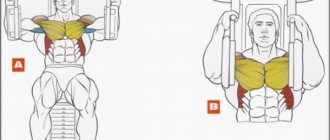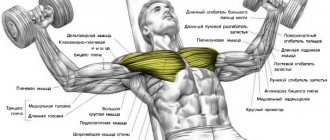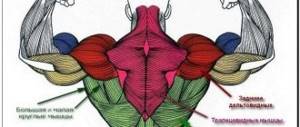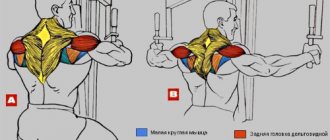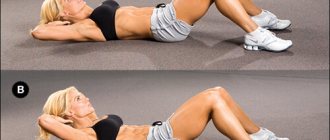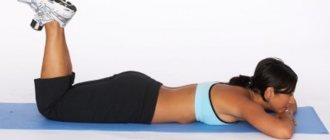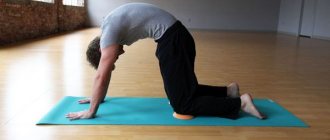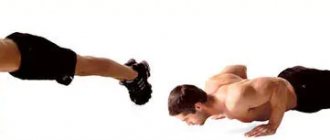What muscles work during pull-ups?
You can do pull-ups in a variety of ways, both with a wide regular grip and a medium reverse grip. Each variation will include different fibers, but the major muscle groups remain the same. When doing pull-ups, the latissimus dorsi, rhomboid, teres major, and trapezius muscles are subjected to heavy loads The biceps brachii, brachialis and brachioradialis muscles also help to pull the body towards the bar
To learn how to do pull-ups on the horizontal bar, perform lifting exercises that involve the same muscles.
Pull-up strength
Thanks to this article we learned how to run. From here we learned how to do push-ups correctly. It’s time to learn how to do pull-ups correctly, especially since it’s not at all difficult and won’t hurt your overall physical development at all. Pull-ups are no worse than push-ups or squats; all these exercises affect different muscle groups and are all useful in their own way. In order to do pull-ups, you need to buy a horizontal bar and have the desire to develop physically. It is best to start with some experience of charging and motivation. I really liked the advice of the mother of one of the Khabrakhabrovites:
“You guys, if you load yourself with strength exercises (push-ups, squats, pull-ups, iron rows) without training (daily) stamina (running, swimming, cycling at least), you will become “room jocks” and with a high degree of probability you will complete push-ups to hypertension. You at least need to walk a lot, but rushing from one extreme to another, now sitting on a chair, now writhing on the floor, is not the case.”
Well, in addition to the possibility of getting hypertension or something worse, you can also be very disappointed in yourself. For example, when I had not yet started doing exercises regularly, I could barely do one pull-up, and even then, somehow. Therefore, some kind of “physical base” is simply necessary. Start doing push-ups, running, squats, walking more, and within a week you can try yourself in pull-ups.
Why pull-ups?
- They are useful for a large number of muscles (forearm muscles, biceps brachii, brachialis, long head of the trapezius, pectoral and latissimus muscles, trapezius, serratus, teres dorsi, posterior head of the deltoid and rhomboid muscles);
- Perfect for people with poor posture and spinal problems (many IT specialists have such problems);
- No need to go to the gym. The crossbar can be bought or found in any yard or sports ground
- Improve well-being and tone the whole body;
- They take a minimum of time (it is enough to allocate 5-10 minutes for training).
Main types of pull-ups
Straight grip
The most common option, but not the easiest. The muscles involved are mainly the back muscles, biceps, forearm flexors and shoulder muscles. To do this, grab the bar shoulder-width apart, cross your legs (if it’s more comfortable) and try to touch the bar with your upper chest (or at least your chin), then straighten up completely and repeat as many times as possible.
Reverse grip
An easier option, but no less common. I recommend starting with it. The main emphasis is on the biceps (which are more pumped up for beginners than the shoulder muscles, which are needed for a direct grip).
It is performed in the same way as a direct grip, only with your palms facing you.
Wide grip
And this is the most difficult option presented. Difficult both in terms of muscle load and execution. The trapezius and latissimus dorsi muscles are involved. Move your hands 10-20 cm from shoulder level (the farther, the more difficult). Pull yourself up, trying to touch the bar with your chest, preferably looking up.
For beginners in pull-ups, I advise you to start with a reverse grip, gradually training in a straight grip. When you reach 3-4 pull-ups with a reverse grip, I advise you to try the widest one.
Types of horizontal bars
There are 2 types:
Door
(inserted into the door opening)
Pros: + Cheaper; + Easier to install.
Cons: - Less convenient (given the specifics of most buildings, there is a very high chance of getting a bump on your head when doing pull-ups); — There are no handles for a wide grip.
Wall
(attached to the wall)
Pros: + There are handles for a wide grip; + More convenient; + More reliable (usually fastened with 4-8 bolts; if the wall is solid, then you are unlikely to be able to bring it down no matter how heavy it is).
Cons: - Less cheap (the difference in price compared to a door door is usually from 400 to 700 rubles)
I was very surprised, but finding a wall-mounted horizontal bar in St. Petersburg turned out to be quite a difficult task. In the end, I found it for 1800 rubles, and it turned out to be the last one at that price...
Afterword
I hope that I will awaken in someone the desire to do pull-ups or even a craving for sports.
Please remember to keep yourself in good shape and improve not only your knowledge and train your brain, but also your body. UPD1 I couldn’t find a beautiful girl who does pull-ups, like in the article about push-ups. But I hope this doesn't stop you from reading the article.
UPD2 If you downvote karma, then explain why you didn’t like the article. Perhaps some additions should be made? UPD3 Now the topic is in a suitable blog, although not by me.
Exercises for learning to do pull-ups on the bar
Wide grip low bar pull-ups
The exercise is an easy alternative to pull-ups on a horizontal bar. By strengthening the muscles on the low bar, resting your feet on the floor, you can gradually develop the necessary muscles and get closer to the heavy version.
Exercise technique:
- Stand facing the bar, set at approximately chest level. The lower the crossbar, the more difficult the load.
- Take a wide grip and walk your feet forward, bringing your torso and legs into a straight line at a 45-degree angle. Sag freely on straight arms.
- As you exhale, bring your shoulder blades together and use your biceps to pull your chest toward the bar. Keep your elbows at right angles, level with your shoulder joints.
- As you inhale, relax your arms and return to the starting position.
- Maintain a straight line throughout your body, do not arch your lower back, or lower your pelvis. Keep all your muscles toned.
Reverse grip low bar pull-ups
This exercise replaces pull-ups with a medium reverse grip. Includes the latissimus dorsi, biceps and forearms. The load is reduced by placing your feet on the floor.
- Grasp the bar with an underhand grip, shoulder-width apart.
- Walk feet first, forming a 45-degree angle.
- With an exhalation, pull the middle of your chest towards the bar, bringing your shoulder blades towards each other.
- As you inhale, gently relax.
Read more about pull-ups on a low bar →
Pull-down of the upper block behind the head
The exercise increases the number of pull-ups on the bar and develops the strength of the latissimus dorsi, teres major, rhomboids, biceps brachii and forearms, as with pull-ups. It is performed in a special simulator on the upper block.
- Grab the handle of the exercise machine with a wide grip, lower yourself onto the seat, rest your hips on the special bolsters.
- Lean forward slightly.
- To exit, pull the handle behind your head without touching the cervical vertebrae. Lower the bar no lower than the back of your head. It is necessary to feel the tension of the back muscles in the lower phase, hold for 1 second.
- As you inhale, gently lift the handle, do not make sudden movements so as not to injure the shoulder joint.
Bent-over dumbbell row.
This exercise with dumbbells will allow you to learn how to do pull-ups on the horizontal bar much faster, using the necessary muscles and ligaments with free weights. In addition to the back muscles, rhomboids, biceps and forearms, the rear deltoids work.
- Take a dumbbell in your right hand.
- Place the palm of your left hand and the knee of your left leg on the bench, find a stable position.
- Right foot on the floor. The hand with the dumbbells is freely lowered below the bench.
- As you exhale, lift the dumbbell to your waist using the main efforts of the latissimus muscle on the right.
- As you inhale, lower gently, stretching the muscles of your back and arms.
- Repeat first on one hand, then also change position, focusing on the right side.
Learn more about one-arm bent-over rows →
T-bar row
The exercise works all the muscles that work during pull-ups, in addition training the teres minor, infraspinatus, and also additionally loads the lower back and abdominal muscles. This exercise also allows you to engage stabilizer muscles and strengthen the ligamentous apparatus.
- Place your feet shoulder-width apart and grab the bar with a special handle.
- Lean your body forward, keeping your back straight at a 45-degree angle.
- As you exhale, perform abdominal rows, stretching your elbows along your body.
- Squeeze your shoulder blades together, tensing your back muscles.
- As you inhale, lower the bar and stretch the muscles without rounding your back.
Read more about the T-bar in this article →
Pull-up on the bar
1. Introductory part.
- building l/s.
- checking appearance and equipment.
- announcement of the topic and purpose of the lesson and explanation of TB
Health and safety training:
- exercises are performed in sportswear;
- Persons who have passed the annual medical are allowed to participate in classes. examination;
- carefully select and fit the sport. shoes;
- provide first aid assistance in case of an accident;
- warm-up
2. Preparatory part.
General strengthening of the body and warm-up before the main part of the lesson.
| 1 | Starting position (IP) – standing, feet shoulder-width apart, arms down, circular movement of the head left and right | 5 times | Exercise for neck muscles |
| 2 | I.P. – standing, feet shoulder-width apart, arms down, circular movements of the shoulders back and forth | 5 times | Exercises to warm up the back muscles |
| 3 | I.P. – standing, feet shoulder-width apart, arms down, circular movements of the arms back and forth. | 10 times | Exercise for the muscles of the shoulder girdle |
| 4 | I.P. – standing, feet shoulder-width apart, hands on the belt, circular movements of the body left to right I.P. – standing, feet shoulder-width apart, hands on the belt, circular movements of the hip joint to the right and left | 10 times10 times. | Exercises to warm up the pelvic muscles |
| 5 | I.P. – lying down, arms shoulder-width apart, legs resting on toes, flexion, extension of arms | 10 times | Exercises for chest muscles |
| 6 | I.P. – sitting at an angle, arms supported behind, bending-extension of legs | 10 times | Abdominal exercise |
| 7 | I.P. – standing, feet shoulder-width apart, jumping up, pushing with both legs, pulling your knees to your chest. | 5 times | Exercises for thigh muscles |
| 8 | I.P. – feet shoulder-width apart, arms lowered, springy bends forward, fingers touching the floor, do not bend your knees | 10 tilts | Muscle stretching exercises |
3. Main part.
Command "To the projectile".
At this command, the firefighter approaches the crossbar and begins to perform the exercise. From hanging on straight arms, pull yourself up to the bar, touch it with your chin and lower yourself down. Each time before starting the exercise for 1 second. a fixed hang is fixed on straight arms. Swinging movements and jerking while performing the exercise are not allowed. The exercise is considered completed if the elbow joints have sufficient range of flexion and extension. After the firefighter completes the exercise, the result is announced to him.
| Age group | Men | Women |
| 1 | up to 25 years | up to 25 years |
| 2 | from 25 to 30 years | from 25 to 30 years |
| 3 | from 30 to 35 years | from 30 to 35 years |
| 4 | from 35 to 40 years | from 35 to 40 years |
| 5 | from 40 to 45 years | from 40 to 45 years |
| 6 | from 45 to 50 years | from 45 and older |
| 7 | from 50 years and older | — |
| Grade | Age groups (men) | ||||||
| 1 | 2 | 3 | 4 | 5 | 6 | 7 | |
| satisfactorily | 12 | 10 | 9 | 6 | 4 | 3 | 2 |
| Fine | 14 | 12 | 11 | 8 | 6 | 5 | 3 |
| Great | 16 | 14 | 13 | 10 | 8 | 7 | 5 |
TB Control the heart rate, give the load only after warming up, place the athletes so that they do not interfere with each other and could not get injured.
Strength endurance on the horizontal bar or how to do more pull-ups
Pull-ups on the horizontal bar are one of the most common and accessible exercises for beginners who want to change something in their life, at least their body and strength indicators. Each of us at least once tried to jump on the horizontal bar and test our strength in this exercise; some no longer tried to achieve results in this matter, while others continued to pull themselves up. So, this article is for those who have continued and want to learn about how to still achieve results in this endeavor.
So, let's start with the fact that pull-ups involve a very large number of different muscle groups, some more and some less, depending on the style of pull-ups. Grip and forearm strength, brachialis, biceps, lats, almost all back muscles, etc. But first you need to develop the right technique, since at least ten high-quality repetitions will be more effective than twenty curves and jerks. How to achieve good technique? Well, to begin with, you should grab the horizontal bar as tightly as possible and try to tense your body, especially your back, in the hanging position. Thus, try to stop the swing, because with it, quite a lot of effort is spent on stabilizing the body, and not on working the muscles. Then you have to count down. In the hanging position, preferably two to three seconds, then rise, the chin should be above the bar, and two to three seconds in the upper position. You go down not completely relaxing your body, but in tension. Accordingly, your arms should extend at the elbows in the lower position, and your legs should be pressed tightly together and straightened.
There are different types of pull-ups, and to improve the result, it is advisable to try everything and not stop at just one.
Let's start with the classics. “Regular” is the gold standard, with your hands shoulder-width apart and the outside of your palm facing you. Accordingly, this type of pull-up smoothly transitions into others by changing the grip width or changing the grip to the opposite one (the inner side of the palm is facing you). You can pull yourself up narrowly - your hands should touch each other, or you can pull yourself up wide - preferably twice as wide as usual. You can use a reverse grip and also change the distance. For a more accentuated back workout, pull yourself wide and behind your back, that is, you should put your head behind the horizontal bar and touch your upper back to the bar.
You need to do pull-ups quite often, and don’t skip workouts. Maintain clean technique. If you have the opportunity to put extra weight on yourself, then go ahead, and if you yourself have excess weight, then it is advisable to lose it. Use different types of pull-ups. And most importantly, at the moment when your muscles fail, try to do at least one more time!
All this will help you achieve results, the main thing is desire.
Execution by day
Pull-ups on the horizontal bar should be done every day 5 times a week. On the first day, you must do at least 5 sets, and the maximum amount of energy must be squeezed out of the body. After each set there are breaks, the duration of which is 90 seconds. Typically, during the training process, it turns out that the body is able to perform more pull-ups during sets 4 and 5, as it adapts to the load.
Pull-ups on the horizontal bar (for weight) on the second day begin with one approach, and you need to squeeze out maximum strength in order to realize the largest number in 1 approach.
The next approach may not be the maximum; after it you need to rest for 10 seconds. This is followed by 1 more approach, and it should be the maximum number of times.
On day 3, pull-ups on the horizontal bar are implemented on the basis of special training sets. You need to complete 9 sets. They include a set of pull-ups, which are usually divided into 3 groups:
- using a wide grip (3 times);
- medium grip (3 times);
- lower grip of a narrow type (3 times).
When performing each set, do not forget about rest. Its duration should be 60 seconds.
The pull-up program on the horizontal bar (day 4) comes down to performing a larger number of sets, in which you need to squeeze out maximum strength under the influence of the load. A special table is compiled in which the number of sets completed on day 4 is recorded. The value should not exceed the parameters of the previous day, and care must be taken that the same grip is not used for more than 3 approaches.
For proper muscle development, it is necessary to give the body a rest, which lasts for 60 seconds and occurs after each set. In the first month, you need to resort to a full set during training. The exercises are performed as long as the arms have the strength to lift the body and fix it at the highest point. It is day 4 of the training process that will take the most time, since its intensity is the most severe.
The fifth day of training on the horizontal bar for beginners comes down to repeating one of the days that has already been completed during the week, and which was the most difficult to cope with. You can repeat all 4 days in a month so that the muscles receive different loads to avoid addiction. The sets should be done so that the exercises are complex. If during your back training you managed to complete all 9 sets, then you can add one more next week. So in a month you will be able to reach 12 sets.
